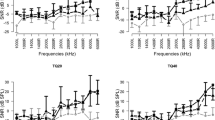Summary
The prime arm of this study is to investigate the influence of therapeutic measures in acute acoustic trauma (AAT). In a controlled clinical trial 209 patients (Table 1) were observed, starting within 2 days after the traumatic event. Various chemical agents, considered to have some influence on microcirculation and metabolism of the inner ear, were administered as shown in Table 2. The control group was treated with NaCl infusions and glucose tablets.
Statistical analysis of the audiometric data was performed in two different ways (Fig. 2). First, variations of absolute pure tone thresholds were studied in a regression analysis, revealing a close dependency of absolute hearing gains upon pretherapeutic hearing losses. Significant differences of permanent threshold shifts between test and control groups could not be observed. Secondly, distribution curves of relative hearing gains (Figs. 1 and 2) were compared using the Kruskal Wallis test. The hypothesis of all of these curves being part of the same sample could not be rejected (p = 0.01).
Thus, it was concluded that the four different forms of polypragmatic therapy used in this trial do not exert an effect on AAT exceeding that of NaCl infusions and glucose tablets. Under the assumption of a placebo effect of NaCl infusions and glucose tablets, either the supply with oxygen and neurotrop vitamins is no limiting factor in the regeneration process of the organ of Corti after an AAT, or the administered drugs fail to influence this supply. The effect of hospitalization with consequent reduction of noise and emotional stress was not studied in this paper.
Zusammenfassung
In einer kontrollierten klinischen Studie wurde an 209 Patienten mit akutem akustischen Trauma (AAT) der Einfluß verschiedener Formen der polypragmatischen Therapie untersucht. Eine Kontrollgruppe wurde mit NaCl-Infusionen und Glukose-Tabletten behandelt.
Grundlage für die Bewertung des Therapieerfolges waren Tonaudiogramme, die vor und nach Therapie geschrieben wurden. In der statistischen Auswertung wurde in einer Regressionsanalyse das Verhalten der absoluten Hörgewinne und in einem statistischen Test das Verhalten der relativen Hörgewinne untersucht. Beide Verfahren ließen signifikante Unterschiede zwischen Test- und Kontrollgruppen nicht erkennen.
Es wurde gefolgert, daß sich mit den vier untersuchten Formen der polypragmatischen Therapie beim AAT keine besseren therapeutischen Ergebnisse erzielen lassen als mit NaCl-Infusionen und Glukose-Tabletten. Über den Einfluß von Hospitalisierung mit Reduzierung des Umgebungslärmes und Meidung von emotionalem Stress kann keine Aussage gemacht werden.
Similar content being viewed by others
Literatur
Beck, Chl., Michler, H.: Feinstrukturelle und histochemische Veränderungen an den Strukturen der Cochlea beim Meerschweinchen nach dosierter Reintonbeschallung. Arch. Ohr.-, Nas.- u. Kehlk.-Heilk. 174, 496 (1960)
Beckmann, G., Herrmann, E.: Untersuchungen zur Beeinflußbarkeit der Innenohrdurchblutung. Arch. klin. exp. Ohr.-, Nas.- u. Kehlk.-Heilk. 194, 534 (1969)
Bredberg, G., Hunter-Duvar, I. M.: Behavioral tests of hearing and inner ear damage. In: Handbook of sensory physiology, Vol. V/2: Auditory System. Keidel, W. D., Neff, W. (eds.), p. 261. Berlin, Heidelberg, New York: Springer 1975
Dieroff, H. G.: Der Einfluß des Vitamin A auf die Lärmschwerhörigkeit. HNO 10, 323 (1962)
Eibach, H., Börger, U.: Akutes akustisches Trauma: Die therapeutische Wirksamkeit von Bencyclan im kontrollierten klinischen Vergleich. HNO 27, 170 (1979)
Eibach, H., Börger, U.: Akutes akustisches Trauma: Bewertung von therapeutischen Ergebnissen in einer Regressionsanalyse. (Zur Veröffentl. einger.)
Faltýnek, L., Veselý, C.: Zum Problem der plötzlich entstandenen Schallempfindungsschwerhörigkeit. Monatsschr. Ohr.-Heilk. 101, 14 (1967)
Herrschaft, H., Gleim, F., Duus, P.: Der Einfluß von Bencyclan auf die regionale Hirndurchblutung bei Kranken mit cerebraler Mangeldurchblutung. Klin. Wochenschr. 52, 293 (1974)
Jahneke, G.: Erfahrungen und medizinische Behandlung knalltraumatischer Hörschäden. Kassenarzt 13, 1712 (1973)
Jakobs, P., Martin, G.: Die Behandlung knalltraumatischer Innenohrschäden mit Dextran 40. HNO 25, 349 (1977)
Kellerhals, B.: Acoustic trauma and cochlear microcirculation. Adv. Otorhinolaryngol. 18, 91 (1972)
Klausberger, E., Rajna, P.: Cerebrale Zirkulationsvorgänge unter der Einwirkung von Bencyclan. Arzneim.-Forsch. 20, 1457 (1970)
Klein, K., Grübl, M.: Zur Bedeutung der Autoregulation bei der Behandlung zerebraler Gefäß-prozesse. Hämodynamische Studien mit Fludilat. Med. Welt 26, 606 (1975)
Kohlmeyer, K.: Untersuchung der Hirndurchblutung mit Xenon-133. Therapiewoche 26, 4516 (1976)
Kup, W.: Akustisches Trauma und progredienter Hörverfall. HNO 8, 265 (1959/1960)
Martin, G., Jakobs, P.: Klinischer Vergleich der Monosubstanzen Dextran 40 und Xantinol-Nicotinat in der Therapie des Knalltraumas. Laryngol. Rhinol. Otol. (Stuttg.) 56, 860 (1977)
Pfander, F.: Das Knalltrauma. Berlin, Heidelberg, New York: Springer 1975
Rüedi, L.: Wirkungen des Vitamin A im menschlichen und im tierischen Gehörorgan. Schweiz. Med. Wochenschr. 84, 1411 (1954)
Sachs, L.: Angewandte Statistik. Berlin, Heidelberg, New York: Springer 1974
Schnurbusch, F.: Klinik und Begutachtung des akuten Schalltraumas. HNL 6, 6 (1956/1958)
Sinzinger, G.: Zur Therapie verschiedener Hörstörungen vom Schallempfindungstyp. Monatsschr. Ohr.-Heilk. 101, 145 (1967)
Suga, F., Snow, J. B.: Cochlear blood flow in response to vasodilating drugs and some related agents. Laryngoscope 79, 1956 (1969)
Theopold, H.-M.: Das akustische Trauma im Tierexperiment. I. Morphologische Veränderungen an der Meerschweinchencochlea nach Knalltrauma (Raster-EM). Laryng. Rhinol. 57, 706 (1978)
Ward, W. D.: Noise-induced hearing damage. In: Otolaryngology, Vol. 2: Ear. Paparella, M. M., Shumrick, D. A. (eds.), p 377. Philadelphia, London, Toronto: W. B. Saunders Comp. 1973
Ward, W. D., Glorig, A.: The relation between Vitamin A and temporary threshold shift. Acta Otolaryngol. 52, 72 (1960)
Author information
Authors and Affiliations
Rights and permissions
About this article
Cite this article
Eibach, H., Börger, U. Therapeutische Ergebnisse in der Behandlung des akuten akustischen Traumas. Arch Otorhinolaryngol 226, 177–186 (1980). https://doi.org/10.1007/BF00455132
Received:
Accepted:
Issue Date:
DOI: https://doi.org/10.1007/BF00455132




